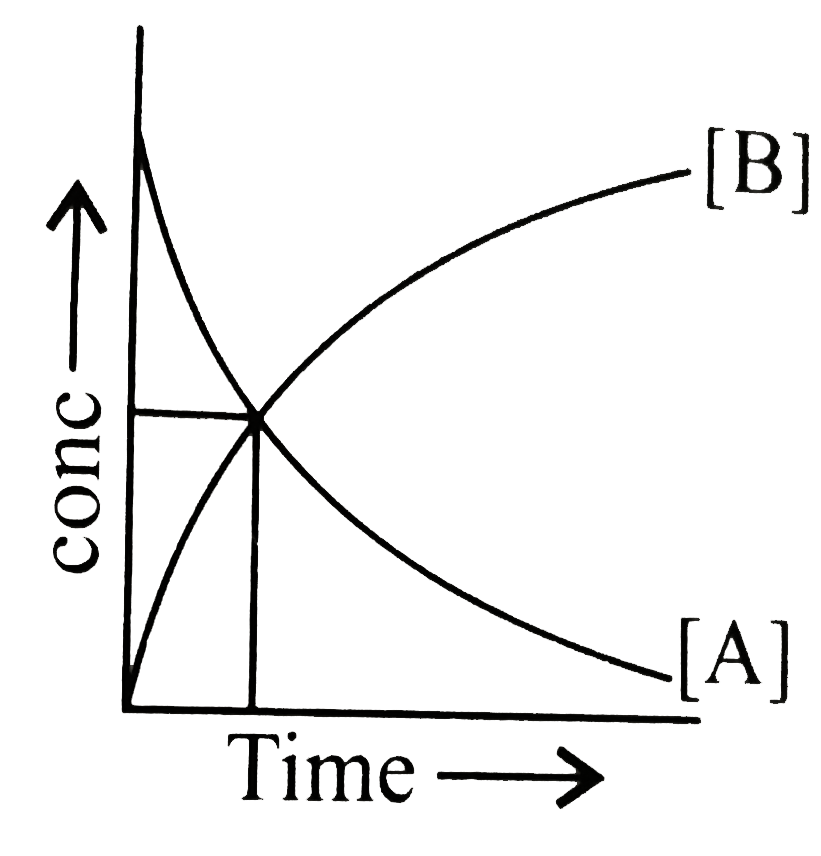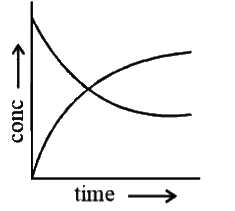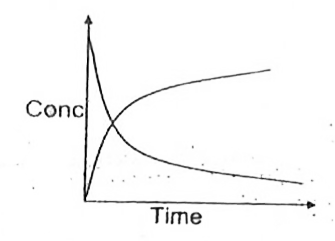The accompanying figure depicts a change in concentration of species A and B for the reaction A→B, as a function of time. The point of inter section of the two curves represents

t1/2
t3/4
t2/3
Data insufficient to predict
The correct Answer is:A
The intersection point indicates that half life of the reactant A is converted to B.
Topper's Solved these Questions
- REACTION KINETICS AND CHEMICAL EQUILIBRIUMBOOK - CENGAGE CHEMISTRYCHAPTER - REACTION KINETICS AND CHEMICAL EQUILIBRIUMEXERCISE - CHALLENGING EXERCISE
5 Videos
- RADIOACTIVITYBOOK - CENGAGE CHEMISTRYCHAPTER - RADIOACTIVITYEXERCISE - OLYMPIAD AND NTSE LEVEL EXERCISES
10 Videos
- THERMODYNAMICS AND THERMOCHEMISTRYBOOK - CENGAGE CHEMISTRYCHAPTER - THERMODYNAMICS AND THERMOCHEMISTRYEXERCISE - OLYMPIAD AND NTSE LEVEL EXERCISES
10 Videos
Similar Questions
The accompanying figure depicts a change in concentration of species A and B for the reaction A→B, as a function of time. The point of inter section of the two curves represents

View SolutionThe figure shows the change in concentration of species A and B as a function of time.
The equilibrium constant Kcfor the reactionA(g)⇔2B(g) is :

View Solution
Knowledge Check
The accompanying figure depicts a change in concentration of species A and B for the reaction A→B, as a function of time. The point of inter section of the two curves represents
 At1/2Bt3/4Ct2/3DData insufficient to predict
At1/2Bt3/4Ct2/3DData insufficient to predictThe accompanying figure depicts a change in concentration of species A and B for the reaction A→B, as a function of time. The point of inter section of the two curves represents
 At1/2Bt3/4Ct2/3DData insufficient to predict
At1/2Bt3/4Ct2/3DData insufficient to predictThe figure shows the change in concentration of species A and B as a function of time.
The equilibrium constant Kcfor the reactionA(g)⇔2B(g) is :
 AKc>1BK<1CK=1Ddata insufficient
AKc>1BK<1CK=1Ddata insufficient
The slope of the tangent at a point on the curve of concentration of a reactant as a function of time gives the instantaneous rate of reaction.
View SolutionAt the point of intersection of the two curves shown for the reaction

A→nB time →
then concentration of B is given by :
View SolutionConsider a reaction, 2A+B→ Products
When concentration of B alone was doubled, the half-life did not change. When the concentration of A alone was doubled, the rate increased by two times. The unit of rate constant for this reaction is :
View SolutionThe slope of the tangent at a point on the curve of concentration of a reactant as a function of time gives the instantaneous rate of reaction.
View SolutionAt the given point of intersection of the two curves shown concentration of B is given by ………for, A=3B

View Solution
